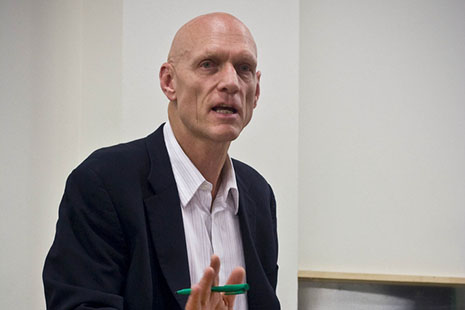AFTER daylight saving was introduced in the United States in the early 1970s the television coverage of early morning traffic accidents intensified, leaving viewers with a strong impression that there was a link between the two phenomena. But there had been no change in the rate of accidents – the media coverage had increased simply because early morning accidents were judged to be more newsworthy in the midst of controversy over daylight saving.
A similar case occurred in New South Wales in the early 1980s, when the Wran government’s head of corrective services, Tony Vinson, sought to introduce urgently needed prison reforms. The new policy was portrayed in some sections of the media as a “softening” of the system, and from that point on every escape was treated as if it were a test of the reforms. Vinson’s policies had made escapes more newsworthy, and little attention was paid to longer-term rates of escape.
In both instances, the news coverage carried an imputation of causality – implicitly, in the pattern of attention, and explicitly, through editorial comment and in the reporting the views of critics. Preoccupied with the present and neglectful of the past, concentrating on individual events and ignoring longer-term patterns of events, the news media conveyed a false causality.
These two cases (and there are many other similar examples) make a useful backdrop to the controversy over the Rudd government’s home insulation scheme and the largely unexamined assumptions about cause and effect that permeated the media coverage. In some eyes at least, the government’s scheme was a morally culpable and scandalous failure. Typical of the journalistic commentary was Laurie Oakes’s description of the program as “a mess. A shambles. A disaster.” At every level it has been a political liability for the government and a triumph for the opposition. It dominated the media agenda for weeks, especially after the revelation that four workers had died while installing insulation and that there had been ninety-four house fires related to insulation. The controversy claimed half a ministerial scalp, with the demotion of Peter Garrett, and also managed to embarrass the prime minister and perhaps tarnish his credibility in the eyes of some potentially swinging voters.
The Coalition’s rhetoric was extreme and unqualified. It climaxed with Tony Abbott’s claim that if Mr Garrett were a company director in New South Wales “he would be charged with industrial manslaughter.” Abbott called the scheme “the most monumentally bungled government program in Australia’s history” and claimed that the government was in “electrocution denial.” His Coalition colleagues joined the attack, with South Australian senator Simon Birmingham claiming that the “greatest threat to the safety of many Australian families over the last twelve months has been the home insulation program.”
The opposition’s framing of the issue was reflected in most reporting and commentary. The narrative was one of disaster and incompetence, especially as the controversy gathered intensity. As Crikey’s Bernard Keane commented, “Once journalists get the smell of ministerial blood in their nostrils, the old higher brain functions start switching off and the pack instinct kicks in.” The government was constantly on the defensive.
Even the denouement (assuming that the affair has run its political course) further damaged the government. Just days after generously praising his environment minister, the prime minister demoted him. And after defending the program, the government suddenly terminated it. The sharp reversal brought fresh criticism, including a torrent of negative publicity about the jobs that would be lost because of the program’s suspension. “Having howled for the program to be shut down, the media and the Opposition [then decried] the consequences of, um, shutting it down,” observed Keane in Crikey. So the government got little credit for the program creating jobs but lots of blame when closing the program cost jobs.
The government also suffered an ideological defeat. The program was taken as evidence of Canberra’s incompetence rather than the shortcomings of small businesses. For John Roskam, director of the Institute of Public Affairs, “this is the problem of Canberra taking control of these big programs without experience.” The Age’s Shaun Carney thought that the “bungled” roll-out tested “Australians’ faith in big government.”
Beyond the immediate damage, the negative publicity fed into existing, damaging narratives about the Rudd government: that it is better at announcing programs than implementing them; that it loves the grand gesture but ignores the detail. Any government will suffer if the presumption of incompetence takes hold, as has become the case for the New South Wales Labor government, and the insulation controversy could damage perceptions of Rudd and his colleagues. Equally heartening to the opposition will be the perception that this case offers further evidence of just how easily Kevin Rudd and his inner circle are spooked when a damaging story seems to be running out of control.
The result is that the home insulation program has entered the conventional wisdom as an unequivocal disaster. To appreciate fully why that is a massive oversimplification, we need to look at three wider issues: the sociology of the economic stimulus; ministerial responsibility in the contract state; and the pre-stimulus history of home insulation in Australia.
Designing the stimulus
THE HOME insulation program arose as one part of the Rudd government’s economic stimulus package during the most foreboding days of the global financial crisis of 2008–09. Like its counterparts around the world, the government was seeking Keynesian solutions to the prospect of a deep and prolonged recession. The theory was that when market forces are working towards a contraction in activity it is up to government, as the biggest economic actor, to create a circuit breaker by stimulating economic activity and increasing demand. Later the boldness and speed of the Rudd government’s initiatives was often (and correctly) seen as causing some of the problems with the home insulation program, and this was usually attributed to the Rudd government’s wish to put the best spin possible on its actions. While true, it was also consistent with the economic demands of the moment, to make a fast and big splash.
As a tool of economic policy, the stimulus worked. Although other factors, including the strong demand from China and the sound position of Australia’s banks, were also important, the stimulus played a central role in making sure that Australia suffered less of a downturn than most other developed countries. The opposition has criticised the public debt that resulted, but compared with most other developed nations this is fairly small. Moreover, the capacity to repay that debt – and, in the meantime, to service it – has been greatly aided by the success of the stimulus in minimising unemployment and boosting output.
Conventionally, there are three main criticisms of economic stimulus measures. The first is that they often consist of “make work” jobs, which do no social or economic good beyond giving their occupants temporary employment, and disappear as soon as the government’s artificial stimulus does.
To preempt this criticism, any stimulus package should focus on projects that will have some lasting benefit, which makes the construction of infrastructure an ideal area. Providing home insulation, in this case, would not only create jobs in the short term but also have the longer-term benefit of reducing the power costs of each household and cutting greenhouse gas emissions. In other words, this was a well-conceived policy with both economic and environmental benefits.
The second and third criticisms relate to the way that government intervention distorts market forces and disciplines. Stimulus measures often lead to a sudden spike in demand in one area, but then this either produces windfall profits for a few suppliers or creates a situation where there is insufficient supply and standards drop. Similarly, the public subsidy leads to prices in that area becoming considerably inflated, and in some cases opens the way for fraud against the taxpayer via claims for services that weren’t actually provided.
Both these problems arose in the home insulation program. As the former treasurer, Peter Costello, said, “Once you announce there is $2.7 billion of free insulation to be distributed, you can hardly be surprised when contractors materialise from thin air to take up the business.” Especially as the program escalated in late 2009, the number of what have been dubbed “rogue” or “cowboy” operators is said to have increased. It also seems that because the public subsidy basically covered the cost of the service, many consumers were less than assiduous in monitoring either the quantity or quality of the work they received, and there may have been some fraudulent claims for payment for work not actually completed.
Ministers and contractors
WHICH BRINGS us to the issue of where ministerial responsibility fits into this mix of public funding and private delivery of services. The term “the contract state” was coined about forty years ago to describe the increasing number of services and products that are neither wholly in the domain of private enterprise nor performed by a government bureaucracy financed from consolidated revenue. They are services undertaken by private contractors at the behest of government, or made possible by government subsidy. Ranging from private schools and private hospitals to private electricity providers and private prisons, these have been increasing over the years.
The Westminster doctrine of ministerial responsibility, already problematic and inconsistently enforced, has not kept pace with this blurring of the lines between the public and private sectors. In the contemporary world, ministers are sometimes held responsible for their own actions. Very rarely are they held to account for the actions of their department, where there are typically debates over what a minister could have reasonably known or controlled. Ministerial responsibility for contracted government services is an even greyer area.
Under the Howard government, despite the Labor opposition’s best efforts, no official sanction was ever administered for any outsourced activities or the effects of the direct or indirect public subsidies to corporate entities. Thus the immigration minister was not required to resign after the suicides and other great human suffering that occurred in the privately run immigration detention centres implementing the government’s asylum seeker policies. The foreign affairs minister was not required to resign because of the way the corporate monopoly entity AWB (formerly the Australian Wheat Board) was dealing illegally with Saddam Hussein’s regime. When the Howard government’s policy of financially supporting child care through tax rebates for parents allowed that sector to become very corporatised, culminating in the collapse of the biggest corporate entity, ABC Learning Centres, no minister was held responsible.
In the home insulation case the Coalition was able to impose a definition of ministerial responsibility far more rigorous than anything previously associated with the Westminster system. Now ministers are not only responsible for their own actions, and those of their departments, but for private employers whose actions are subsidised by the government. As Bernard Keane wrote, “The crazy logic of the pursuit of Garrett is that he must take responsibility for the actions of everyone who has received government funding, no matter how irresponsible they are in their own actions.” Peter Garrett is probably the first minister to suffer a demotion because of activities by private contractors drawing on public money.
In the pursuit of the issue, Tony Abbott, Peter Costello and former Liberal leader Malcolm Turnbull presented characteristically contrasting styles. Abbott went straight for the jugular with the claim that Garrett could be charged with industrial homicide. This could have easily rebounded on him if a more critical media had branded the comment as outrageous and irresponsible. Instead it worked for him, raising the political temperature and dramatically putting the public focus on the government’s culpability. Equally characteristically, Costello was smugly dismissive of the whole insulation scheme, recalling in the Age that Turnbull had wanted to undertake a similar program in government, “dressed up as a climate change policy.” “I was against it. I couldn’t see why those taxpayers who had paid to insulate their own homes should subsidise insulation for those who hadn’t. The subsidy would only [emphasis added] increase the value of a private asset – the private home.” Costello says he saved Turnbull from what would have been a disaster, and “the voters saved $2.5 billion.” Under Rudd it was “rebadged as a stimulus policy” (actually it was titled “The Energy Efficient Homes Package”) and, inevitably, says Costello, it became a mess. Finally, and predictably, Turnbull mounted the most forensically (if not politically) effective attack. He said that the scheme showed again that Rudd is not a cautious, process-obsessed bureaucrat but rather a free-wheeling spin merchant, and criticised the lack of planning and preparation before launching the program. He also argued, quite plausibly, that if the rebate covers the whole cost of installation, then the householder has less interest in seeing it is done properly.
It is interesting that conservative critics studiously avoid acknowledging any difference between the actions of government bureaucracies and those of businesses receiving public money. Costello extended his critique of the home insulation program by proceeding to criticise “the idea that the Commonwealth should take over and run [emphasis added] public hospitals,” while the IPA’s Roskam attributed the problems with the home insulation program to “Canberra taking control.” In fact it is meant to be one of the virtues of the contract state that the public outsourcing of activities achieves market disciplines and efficiencies in contrast to government bureaucracies undertaking them.
Insulated from history
TO EVALUATE the achievements and failings of the scheme, it is important to recognise that home insulation was already a sizable industry. The government’s policy did not introduce new activities; it radically increased the scale of existing practices. So, in assessing the government’s responsibility for developments during 2009 and early 2010, the task is to disentangle which problems arose from an accentuation of existing sub-standard practices and which occurred because of an emphasis on quantity over quality and a drop in standards as new operators flooded into the industry. While some conclusions – for example, that the standard of work fell – are plausible, we can’t know for certain because there are no baseline measures of previous practices and outcomes.
In 2008, 3.18 million Australian dwellings (or 61 per cent) had insulation, and approximately 67,000 homes were insulated each year. The largest number of insulated homes had batts in the ceiling; a minority used foil. On average, between eighty and eighty-five fires per year were attributed to insulation faults, but no breakdown is available to show which of these arose from newly installed insulation and which from longer-standing insulation.
The Rudd government’s scheme was unprecedented in its scope, aiming to insulate two million homes in two and a half years at a cost of $2.45 billion. By the time the program was suspended last month, 1.1 million homes had been insulated with $1.4 billion approved for payment. These installations amount to roughly half the number of homes that had no insulation in 2008. It should also be remembered that the work done was disproportionately in older dwellings, which no doubt added to the difficulties of safe installation.
The benefits of home insulation have not been questioned by any of the program’s critics. The Department of Environment estimated that insulation would cut the normal household’s energy bills by around $200 a year. According to one estimate during the controversy, putting ceiling insulation in 2.2 million homes would save as much energy as taking a million cars off the road; a more conservative estimate said that 1.1 million insulated homes was the equivalent of taking 300,000 cars off the road. Another estimate said that ceiling insulation cuts household energy use by up to 45 per cent, while the Total Environment Centre said it would cut it by 25 per cent in centrally heated homes and 18 per cent in space-heated homes. Whatever the actual figures, the environmental benefits are clearly substantial.
When the program began, home insulation had few special regulations, although it was, of course, subject to normal work and safety provisions and employers’ duty of care. No certification was needed to enter the field, and indeed insulation was frequently installed by householders themselves. The lack of licensing and training in the area allowed sub-standard work to be completed and sub-standard occupational safety procedures to be followed. Although the numbers and proportions of each almost certainly increased as a result of the stimulus, the lack of existing safeguards also meant that an unknown number of instances of both shortcomings probably occurred in the past but had passed beneath the public radar.
Both licensing and training have been dramatically improved as a result of the program. As the increased scale and perhaps the decline in the quality of some work exposed more problems, the department mounted a national training and audit program, largely filling the regulatory vacuum that had permitted the previous abuses and problems. At best there is a grey area here. On the one hand it can be argued that it would be unreasonable for the department to anticipate all of these issues, and it can be argued that it acted fairly quickly once problems became apparent. On the other, should it have anticipated that such an expansion of funding would attract problematic operators and practices, and therefore acted pre-emptively?
“Every new fire and its front page headline will remind voters of the Rudd government’s recklessness and ineptitude,” the Australian’s columnist Janet Albrechtsen has written. Politically, she is surely correct, but that will happen largely because of the media’s innumeracy and lack of historical perspective. Under the program, the number of installations rose from 67,000 a year to 1.1 million; the number of fires rose from around eighty to 120. In other words, as Crikey’s psephological blog Pollytics has demonstrated convincingly, there is no statistical evidence that the existing problem of fires became worse with the program. Rather, because fires from insulation were now newsworthy and previously hadn’t been, this was seen as a new problem, one caused by the new policy, whereas in fact the number of insulation-related fires increased only slightly in absolute terms, and there was a decrease from previous patterns in proportional terms.
The most tragic aspect of the current controversy was the death of four young workers. Although the coronial inquiries are not yet complete, one apparently died from heat exhaustion on his first day in the job and two others from cutting through live electrical wires. We have no figures on deaths from home insulation before the program began, as the published figures have not been disaggregated from overall fatalities in the construction industry. But we do know that each year there are around 50 fatalities from construction work in Australia, and overall in Australia around 300 work-related fatalities. As Bernard Keane reported in Crikey, this number actually increased somewhat after the Howard government’s changes to the building code in 2004 – from 3.14 deaths per 100,000 in 2004 to 5.6 in 2006 and 4.48 in 2007.
Every one of the 300 work-related deaths that occur each year in Australia is a tragedy, not only the four associated with home insulation. Every one of them should be an occasion for examining existing policies and practices, and many of them should have received more media and political attention than they have. Few if any of them, though, should result in charges of industrial homicide against cabinet ministers.
Three of the deaths involved foil insulation. Foil seems to have particular safety problems in proximity to live electricity currents, both during installation and later, as conditions in ceilings change and some areas potentially become electrified. Foil has been used for decades and problems appear to have existed, unacknowledged, for a long time. Now, thankfully and at last, these have come into public focus. I do not recall seeing any warnings about the dangers of foil insulation when the program started.
Insulation proved to be a much more problematic industry than anyone anticipated when the government’s program began. Questions can be raised about the speed and adequacy of the government’s responses as problems came to light, but here even a harsh critic must concede that on several issues it acted fairly promptly and properly, although there is certainly legitimate scope for divergent judgements about this. Nevertheless this is a much more limited and partial sense of responsibility than could justify the general claims of recklessness and industrial homicide that became standard fare during the controversy.
THE HOME insulation saga has been indelibly defined as a fiasco. It will be used relentlessly against the government as incontrovertible evidence of incompetence. At the National Press Club debate on health this week, for instance, Tony Abbott said three times that a government that was incapable of rolling out pink batts couldn’t be trusted to run hospitals.
But what was most striking about the political controversy was the stultifying and misleading narrowness of the news agenda. It was depressing testimony to how seldom a complex or rounded picture emerges in political reporting. The trade-offs in policy – between speed and size on the one hand, and careful preparation and targeting on the other – never emerged in the news. The home insulation program had considerable flaws, but in news reports these all but completely eclipsed its virtues. The economic and environmental achievements of the program never came into focus.
The media controversy was framed almost entirely by the political conflict. The problems that emerged so spectacularly were a mix – in unknowable proportions – of shortcomings that had always existed in the industry, which now occurred in larger numbers because of the increased scale of home insulation activities, and shortcomings that the government subsidy and stimulus made worse because of the increase in unqualified operators and the lack of constraints on shoddy work practices.
As interesting as the urgent emergence of these problems under Labor was their previous neglect. Insulation-related fires and electrocutions had been beneath the public radar for a long time, probably decades, and they only received news attention because of the political conflict surrounding the government’s scheme.
The beguiling narrative of government blame and total failure owes quite a bit to a media that pursues controversies with little curiosity about history and a defiant innumeracy that treats every event as unique, and in the process presents a lop-sided causality and simplistic moral absolutism. •




